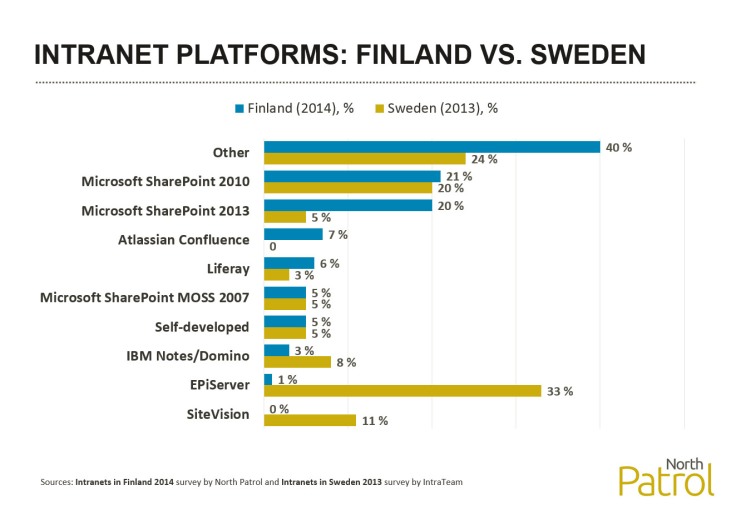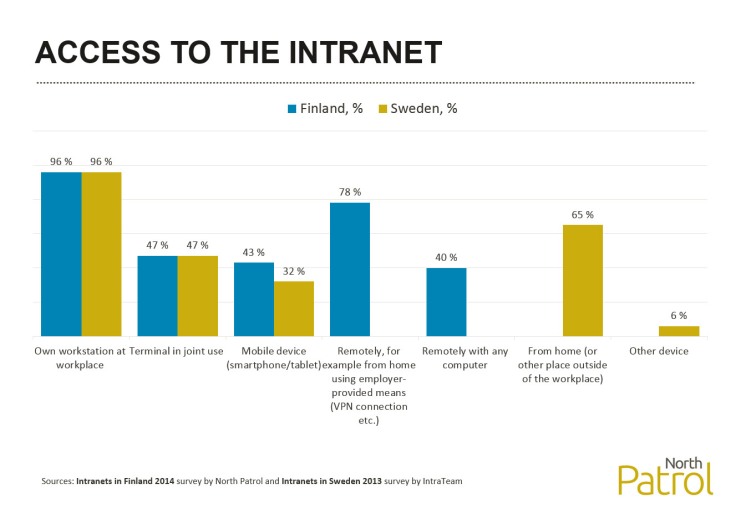Finland and Sweden often arrange playful competitions between each other. We challenged both countries to an “intranet open” comparing the freshly published results of the Intranets in Finland 2014 survey with the corresponding survey in Sweden. The topics include intranet platforms, access to intranets, usage activity, content and functionality, and intranet governance models.
North Patrol is a consulting firm specialized in the design of digital services and information systems. We shape ideas into a vision and service concept, find the best architectural and technological solutions, design a functional user experience, and compete to find the ideal partner for implementation work. We do not sell implementation projects, nor do we sell licenses; we are genuinely on the side of the customer.

For comparison, we use the most recent Swedish survey, Intranät i Sverige 2013 (Intranets in Sweden 2013), compiled by IntraTeam’s Kristian Norling, the results of which were published in early 2014. In Sweden, the survey runs for many years, whereas in Finland it was the first ever.
EPiServer dominates as platform in Sweden
In Finland, the most popular intranet platform is SharePoint, in Sweden EPiServer. 33% of Swedish intranets run on EPiServer.

(Note: Both surveys allowed respondents to select more than one system platform from among the alternatives. The most seldom mentioned platforms are combined under “Other”. Atlassian Confluence was not included in the Swedish survey as an alternative, which is why there is no comparison data for it.)
EPiServer’s dominance is explained by the platform’s Swedish origins.
— EPiServer’s supremacy as the most popular intranet system comes from its extremely strong position in all online publishing scenarios in Sweden, says Perttu Tolvanen, Web & CMS Expert, North Patrol.
— EPiServer is a Swedish product that has built its position in its home country for years, which is why not even SharePoint has fully succeeded in challenging it on its home turf, Tolvanen continues.
— EPiServer isn’t a bad intranet platform by any means, especially if you want social features, and particularly if you need language versioning. Its language version management is EPiServer’s trump card in comparison, for example, with SharePoint. That’s why large corporations sometimes consider it for their intranets even in Finland.
SiteVision’s popularity in Sweden is another remarkable finding. In Finland, this platform was not mentioned at all. Perttu Tolvanen continues:
— SiteVision is EPiServer’s most notable challenger as an online publishing tool in Sweden, but it has a dominant challenger position also in intranets despite its small footprint. For example, SiteVision is significantly more advanced in its social functions and document management than EPiServer, and on the whole, a somewhat more agile product than SharePoint. Despite its good integrator network, however, SiteVision is a very local product in Sweden, and its market position is largely anchored in its market share in Swedish local government.
In Sweden, slightly more than half (52 %) of organizations use the same platform for their intranet and their public-facing websites. In Finland, the same platform for the intranet and public websites is being used by less than one-third of respondents (28 %).
— EPiServer’s ubiquity makes the use of the same system for both purposes more attractive than the use of SharePoint in Finland. In Sweden, communicative intranets are a more popular concept than in SharePoint-dominated Finland, where group workspaces and document management are usually seen as an integral part of intranets.
No differences in intranet access
There are no real differences between Finland and Sweden when it comes to devices used to gain intranet access. Surprisingly even are the figures for intranet access possibilities from employees’ own workstations at the workplace (96 % in both countries) and the use of joint terminals (47 % in both countries).

(Note: The questionnaire in Finland went a bit deeper into the remote use of the intranet than in Sweden. In Sweden, the use of a VPN or other encrypted connection was not surveyed separately.)
Only mobile use is slightly more often possible in Finland (43 %) than in Sweden (32 %). The difference in these figures may be due to the timing of the surveys: the Finnish one was conducted about six months later than the Swedish one.
Intranets somewhat more actively used in Finland
In both countries, respondents were asked to estimate the number of users who use the intranet daily, based on statistics or the respondents’ own estimates. The choices in both surveys differed somewhat, which is why the figures for this area are not totally accurate.
In any case, Finnish respondents estimated that their intranets were more actively used than their Swedish counterparts. In Finland, 60 % of the respondents said that their intranets are used daily by at least half of the potential users whereas in Sweden this could be stated by only 48 % of the respondents.
I believe the degree of activity is connected with what the intranet is used for. For example, whether it is only for communication (instructions, policies, internal communications) as is typical for EPiServer-based intranets, or whether the intranet is also a platform for teamwork, as is typical for SharePoint intranets.
Communications runs the intranet also in Sweden
In both Finland and Sweden, the communications department is the typical owner of the intranet (see table below). The second most usual owner in both countries is IT.
Table: Intranet owner
Finland
| Sweden
|
The Finnish results surprised us by the near non-existence of Human Resources as the intranet owner. In Sweden, the figure is significantly higher with one in ten intranets being owned by HR.
Another noteworthy observation is that in Finland, more than ten percent of intranets don’t have a nominated owner. In Sweden, this happens in only a couple of cases.
Governance model hot topic in Sweden
We asked about the governance of the intranet at a general level in the Finnish survey: “Is your intranet governance goal-oriented and methodical? Is the intranet a tool for realizing your strategy?”
In Finland:
- 23% of respondents say their intranet is absolutely governed with the goal in mind and methodically as a tool for realizing strategy.
- 56% say their intranet is “somewhat” governed with the goal in mind and methodically.
- 22% say their intranet is “not really” governed with the goal in mind and methodically.
In the Swedish survey, intranet governance was addressed through different means.
In Sweden:
- 73% of respondents monitor user statistics
- 35% implement usability testing
- 33% measure the value of the intranet from the users’ point of view
— Governance models are now a hot topic in the Swedish world of intranets, says Kristian Norling, who conducted the survey in Sweden.
— Many organizations have taken important steps forward in making intranet development the responsibility of nominated employees, which has led to more tangible goals for the intranet being set by the management. In comparison with earlier years, many Swedish organizations have been successful in making the role of their intranet more important, and most importantly, initiating a dialogue with top management that makes the final decisions on resources.
Content and functionality
According to the results of the Swedish survey, the main goals of intranets are communication, making work easier, and supporting the needs of the organization.
The Finnish survey went into more detail about individual intranet content and functionality than the Swedish one. That is why it is possible to compare only certain separate content and functionality items, which do not add up to a comprehensive overview. Below is a comparison of content and functionality items, although they are not completely comparable one-to-one on all cases.
It is, however possible to draw the conclusion that Sweden has clearly more segmentation and personalization. This is due to the possibilities of the most popular platform, EPiServer, whereas in Finland the typical platform is SharePoint that does not lend itself to profiling as easily as EPiServer.
Table: Intranet content and functionality (Feature being used by % of respondents.)
Finland
| Sweden
|
Videos one of the future trends in both countries
What are the future trends of intranets, then? Kristian Norling puts videos at the top of the list. Video content is growing significantly also in Finland. Videos vary from high-budget strategy reviews to instructional videos on, for example, the use of a machine or device, shot with a smartphone camera.
I also determined videos to be one of the six intranet megatrends in Finland. These megatrends are discussed in another blog post: First-ever intranet study in Finland reveals six megatrends.
Summary
To summarize, the most important difference between Finnish and Swedish intranets is the platform used. EPiServer holds the number one position in Sweden; Finland’s number one, SharePoint, is in the second place in Sweden. The different system platforms affect the results on how actively the various intranet features, such as segmentation or profiling, are used.
In the light of the surveys, there are no significant differences between Finland and Sweden when it comes to the role of the intranets. Intranets are being used for social purposes and communication, and approximately half of them also for teamwork. In both countries, the intranet owner is usually the communications department. In Finland, intranets are slightly more actively used. Mobile access and usage is also more common in Finland than in Sweden.
